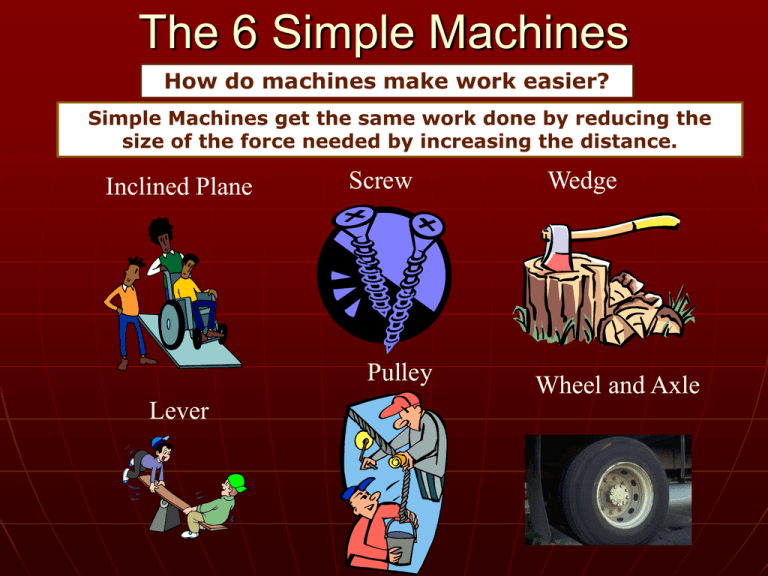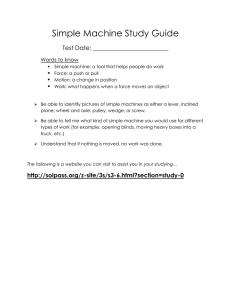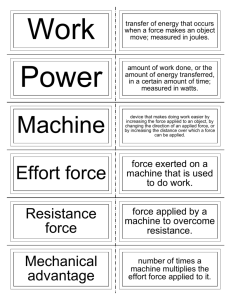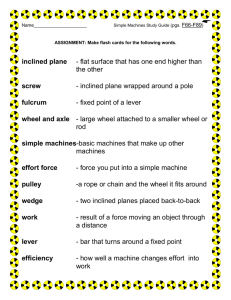The 6 Simple Machines
advertisement

The 6 Simple Machines How do machines make work easier? Simple Machines get the same work done by reducing the size of the force needed by increasing the distance. Inclined Plane Screw Pulley Lever Wedge Wheel and Axle Simple Machines Simple machines make work easier for us by allowing us to push or pull over increased distances Simple Machines Booklet Project Fold 2 pieces of blank paper in half to make an 8 page booklet. Format: (24 AP; 3 points per page) • Page 1 – Cover Page • • • • • • • Title, Colored Illustration, Author Information (name and period) Page Page Page Page Page Page Page 2 3 4 5 6 7 8 – – – – – – – Inclined Plane Lever Pulley Screw Wedge Wheel & Axle Definitions For Pages 2 – 7 On each page, provide an illustration of an example, definition, and a descriptive caption explaining how the simple machine makes work easier (20 word min). Define Energy, Work, Force, Machine, Complex Machine, Technology, Mechanical Advantage, and Efficiency Definitions: Energy: The ability to do work • Measured in Joules Work = Force x Distance • Measured in Joules Force: A push or a pull • Measured in Newtons How do machines help you do work? Machine-any device that helps people do work. • Examples Technology-the use of knowledge to create products or tools that make life easier. • Humans have been improving their lives for thousands of years with technology. • The simplest machine is an example of technology. How do machines help you do work? Machines make work easier by • (1) changing the size of the force needed or by • (2) changing the direction in which the force is exerted 1 pulley W=Fd More distance so less force Much easier than lifting 4 pulleys W=Fd More distance so less force Very little force need The 6 Simple Machines Inclined Plane Screw Pulley Lever Wedge Wheel and Axle Inclined Plane Inclined Plane The Egyptians used simple machines to build the pyramids. One method was to build a very long incline out of dirt that rose upward to the top of the pyramid. Then blocks of stone were placed on large logs (another type of simple machine - the wheel and axle) and pushed slowly up the long inclined plane to the top of the pyramid. Inclined Planes Inclined plane - a simple machine that is a sloping surface. W=Fd Makes work easier by increasing the distance The lower the slope of a ramp the less force needed to lift the object. Screw •The screw is an inclined plane wrapped around a cylinder or cone to form a spiral. •It is used to raise and lower weights and hold objects together. •Examples are drills, jar lids, nuts and bolts. •The spiraling inclined plane that sticks out from the body of the screw forms the threads of the screw. •The threads increase the distance, which decreases the force needed to turn the screw. Two inclined planes joined back to back Wedges are used to split or hold objects together Examples: axe blade, knife, chisel, door jam The thinner the wedge, the less force is needed to press it into something (knife) Small surface area means greater pressure • Thinner blades have greater pressure Wedges Lever A lever is a solid bar that rotates, or turns, around a fixed point. The fixed point is called a fulcrum. A lever can multiply the input force and change the direction of the force. The way in which a lever changes an input force depends on the position of the fulcrum. First Class Lever • Common examples of first-class levers include crowbars, scissors, pliers, tin snips and seesaws. Second Class Lever Examples of second-class levers include nut crackers, wheel barrows, doors, and bottle openers. Third Class Lever Examples of third-class levers include tweezers, arm hammers, and shovels. Wheel & Axle The wheel and axle act like a rotating collection of levers. The axle is like a fulcrum. When the axle turns the wheel, there is greater distance and therefore less force that needs to be applied from the axle. Wheel & Axel The axle is stuck rigidly to a large wheel. Fan blades are attached to the wheel. When the axel turns, the fan blades spin. Pulleys Pulleys are wheels and axles with a groove around the outside The single pulley makes work easier by changing the direction of the force A pulley needs a rope, chain, or belt around the groove to make it do work Mechanical Advantage Mechanical advantage (MA) measures the ratio of how much the machine changes the force. Input force – the applied force Output force – the resulting force MA=Output force/Input force Work Input and Output When work is done energy is transferred • A machine increases the potential or kinetic energy of an object by doing work on it. If distance increases the force decreases. W=Fd Efficiency Work input is the amount of work done on a machine. • Input force x Input distance Work output is the amount of work done by a machine. • Output force x Output distance Output work is always less than input work. Efficiency is the ratio of a machine’s output work to the input work. Efficiency (%) = Output work/Input work x 100 • Friction No real machine is 100% efficient because machines lose energy to friction, which is why we lubricate moving parts and used streamlined designs. Compound Machines A machine that is made of two or more simple machines is called a compound machine. Gears are an example of a compound machine (2 wheel & axles). The mechanical advantage of a compound machine is the product of their mechanical advantages. Example: the mechanical advantage of a pair of scissors is the product of its 2 levers and 2 wedges. GEARS-Wheel and Axel Each gear in a series reverses the direction of rotation of the previous gear. The smaller gear will always turn faster than the larger gear. Combined Pulley A multiple pulley system makes work easier by changing the distance over which work is done and therefore decreases the force required. The main disadvantage is it travels a very long distance. Rube Goldberg Machines Rube Goldberg machines are examples of complex machines. All complex machines are made up of combinations of simple machines. Rube Goldberg machines are usually a complicated combination of simple machines. By studying the components of Rube Goldberg machines, we learn more about simple machines Safety Device for Walking on Icy Pavements When you slip on ice, your foot kicks a paddle (A), lowering finger (B), snapping turtle (C) extends neck to bite finger, opening ice tongs (D) and dropping pillow (E), thus allowing you to fall on something soft.






